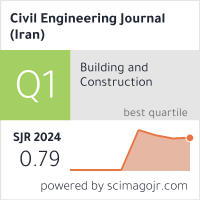Experimental and Numerical Analysis of the Behavior of Steel Scaffolding
Downloads
Doi:10.28991/CEJ-2025-011-05-014
Full Text:PDF
Downloads
[2] "ŽEN 1991-1-1. (2002). Eurocode 1: Actions on structures - Part 1-1: General actions - Densities, self-weight, imposed loads for buildings. European Committee for Standardization, Brussels, Belgium.
[3] "Ž EN 1993-1-1:2005. (2005). Design of steel structures - Part 1-1: General rules and rules for buildings. European Committee for Standardization, Brussels, Belgium.
[4] BS EN 12811-1:2003 (2003). Temporary Works Equipment - Scaffolds. Performance requirements and general design. British Standards Institution, London, United Kingdom. doi:10.3403/03061625u.
[5] Chu, Q., Liu, H., Xia, S., Dong, J., Lei, M., Tse, T. K. T., Teng, L., Li, C. Y., & Fu, Y. (2022). Numerical and Experimental Study on the Member Performance and Stability Bearing Capacity of Wheel Coupler Formwork Supports. Applied Sciences (Switzerland), 12(20), 10452. doi:10.3390/app122010452.
[6] Lu, Y., Lin, T., & Wu, L. (2025). Experimental study on integrated of steel protective mesh and disk lock scaffold. Journal of Constructional Steel Research, 227, 109321. doi:10.1016/j.jcsr.2024.109321.
[7] Zhang, H., Chandrangsu, T., & Rasmussen, K. J. R. (2010). Probabilistic study of the strength of steel scaffold systems. Structural Safety, 32(6), 393–401. doi:10.1016/j.strusafe.2010.02.005.
[8] Weesner, L. B., & Jones, H. L. (2001). Experimental and analytical capacity of frame scaffolding. Engineering Structures, 23(6), 592–599. doi:10.1016/S0141-0296(00)00087-0.
[9] Huang, H., Peng, Z., Hou, J., Zheng, X., Ding, Y., & Wu, H. (2024). Study on the Ultimate Load-Bearing Capacity of Disc Buckle Tall Formwork Support Considering Uncertain Factors. Buildings, 14(3), 828. doi:10.3390/buildings14030828.
[10] Pieńko, M., & BŠ‚azik-Borowa, E. (2020). Experimental studies of ringlock scaffolding joint. Journal of Constructional Steel Research, 173, 106265. doi:10.1016/j.jcsr.2020.106265.
[11] Chandrangsu, T., & Rasmussen, K. J. (2011). Investigation of geometric imperfections and joint stiffness of support scaffold systems. Journal of Constructional Steel Research, 67(4), 576-584. doi:10.1016/j.jcsr.2010.12.004.
[12] Zhang, L., Liu, J., Tang, Q., & Liu, Z. (2023). A numerical study on rotational stiffness characteristics of the disk lock joint. Journal of Constructional Steel Research, 207, 107968. doi:10.1016/j.jcsr.2023.107968.
[13] Do Lee, H., Won, J. H., Jang, N. G., Mha, H. S., Jeong, S. choon, & Kim, S. (2020). Experimental Study on Load Carrying Capacity Enhancement of System Supports Considering Full Installation of Bracing Members. International Journal of Steel Structures, 20(6), 2051–2067. doi:10.1007/s13296-020-00430-5.
[14] Takahashi, H., Ohdo, K., & Takanashi, S. (2011). Experimental study and evaluation method for the buckling strength of scaffold. Procedia Engineering, 14, 297–303. doi:10.1016/j.proeng.2011.07.036.
[15] Kim, H., Lim, J., Lee, J., Kang, Y. J., & Kim, S. (2021). Experimental investigations on ultimate behavior of fabricated mobile scaffolds. Metals, 11(6), 851. doi:10.3390/met11060851.
[16] Peng, J. L., Chen, K. H., Chan, S. L., & Chen, W. T. (2009). Experimental and analytical studies on steel scaffolds under eccentric loads. Journal of Constructional Steel Research, 65(2), 422–435. doi:10.1016/j.jcsr.2008.03.024.
[17] Alqattan, H. F., El Aghoury, I. M., & Ibrahim, S. A. B. (2024). Experimental investigation and analytical modeling of steel falsework systems. Structures, 70, 107623. doi:10.1016/j.istruc.2024.107623.
[18] Mercier, C., Khelil, A., Al Mahmoud, F., Blin-Lacroix, J. L., & Pamies, A. (2021). Experimental investigations of buckling behaviour of steel scaffolds. Structures, 33, 433–450. doi:10.1016/j.istruc.2021.04.045.
[19] Balኾ, I., Koleková, Y., Agüero, A., & Balኾová, P. (2023). Consistency of Imperfections in Steel Eurocodes. Applied Sciences (Switzerland), 13(1), 554. doi:10.3390/app13010554.
[20] Morel, J. (2005). Calculation of Metallic Structures according to Eurocode 3. Eurocode, Brussels, Belgium. (In French).
[21] ISO 6892-1. (2019). Metallic materials-Tensile testing-Part: Method of test at room temperature. International Organization for Standardization (ISO), Geneva, Switzerland.
[22] EN 10002-1:2001. (2001). Metallic materials”tensile testing: I. Method of test at ambient temperature. European Committee for Standardization, Brussels, Belgium.
[23] Grajçevci, F., Mujaj, A., Kryeziu, D., & Shehu, E. (2024). Experimental and Numerical Analysis of Concrete Columns under Axial Load Based on European Design Norms. Civil Engineering Journal (Iran), 10(2), 419–430. doi:10.28991/CEJ-2024-010-02-05.
[24] Peng, J. L., Wu, C. W., Chan, S. L., & Huang, C. H. (2013). Experimental and numerical studies of practical system scaffolds. Journal of Constructional Steel Research, 91, 64–75. doi:10.1016/j.jcsr.2013.07.028.
[25] Peng, J. L., Wang, P. L., Chan, S. L., & Wu, P. K. (2020). Experimental Study on Load-Bearing Capacities of Frame-Type Scaffolds Used in Precast Construction. International Journal of Steel Structures, 20(2), 400–414. doi:10.1007/s13296-019-00292-6.
[26] Abdel-Jaber, M., Abdel-Jaber, M. S., & Beale, R. G. (2022). An experimental study into the behaviour of tube and fitting scaffold structures under cyclic side and vertical loads. Metals, 12(1), 40. doi:10.3390/met12010040.
[27] Grajçevci, F., Mujaj, A., Kryeziu, D., Rrudhani, G., & Shkodrani, N. (2024). Experimental and Numerical Research on the Behavior of Steel Columns with Circular Hollow Cross Sections. Civil Engineering Journal (Iran), 10(5), 1577–1588. doi:10.28991/CEJ-2024-010-05-014.
- Authors retain all copyrights. It is noticeable that authors will not be forced to sign any copyright transfer agreements.
- This work (including HTML and PDF Files) is licensed under a Creative Commons Attribution 4.0 International License.![]()















